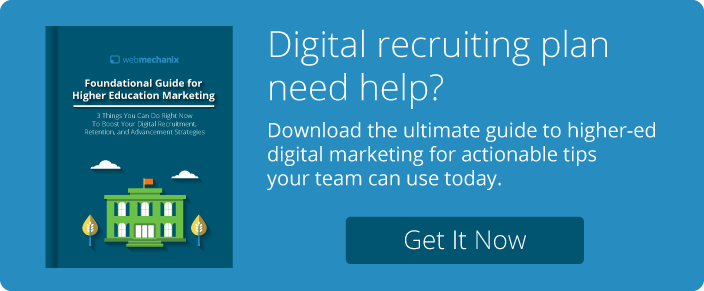
Website Usability Trends in Higher Education Marketing
Technology has changed the way people interact with information. It used to be that organizations would make their information available and people adapted to it. With today’s consumers becoming more and more tech savvy and search-capable, trends in higher education marketing must adapt to their needs.
That leaves a gaping question: “Who is my audience and what do they need?’”
- Determining your audience
- Understanding how website analytic platforms can help
- Meeting the needs of your audience
Who Is Your Audience?
When you are evaluating your website, several things must happen. First, you need to ask, “What is our message?” Knowing what you want to say becomes the foundation for any website, but that foundation become useless without a direction.
Once you have established your message, you need to ask, “Who is our audience?” The same message can be presented in a variety of ways, depending on your audience. You can create a beautiful website that meets all of the visual design tools in the book, but if it ignores your audience’s needs, you’ve failed.
Talk about who you want to reach. Ask yourself what their interests are, what they like to do, how they communicate, and how they digest information. Armed with this knowledge, you can create a website that conveys your message in a way that moves your audience to action that will increase how many prospective students apply to your school, or an action that will increase the traffic flow of charitable donations.
Did you know that according to a recent Pew Research study, 91% of teens go online using a mobile phone and of those teens who use mobile devices, 94% go online daily or more often? Are teenagers part of the audience you’re targeting? Is your website mobile user friendly? Asking yourself questions about who your potential audiences might be will help you create content geared specifically for them.
Even in this post, we didn’t start writing and hope for the best. We created personas for an audience who we thought would be interested in our product and tailored it to you. That’s just how it works. As you are aware, we didn’t get everything right because we can’t pretend to know everything about you, but we constructed a good idea and shaped our content for you.
What Are Website Analytic Platforms?
Knowing how your audience interacts with your website now will allow you to use trends in higher education and website usability to increase your number of applicants. You can also use these trends to increase the number of charitable donations to your school While there are many levels of contact with a website, you want your visitors to engage, not browse.
The first step in usability testing is to use state of the art technology and tools that tell you how people interact with your website as-is. There are several methods to use to understand this interaction:
- General Reports:
- These reports will provide you with information ddke the number of visits to your site, where they’re coming from (ddnks from emails or social media), and where they go from page to page within your website.
- Visitor Displays:
- With this tool, you can watch how an individual interacts with your website to get a feel for how well they can navigate your site. If it seems they’re struggddng, the most ddkely culprit is your site, not the individual.
- Heatmaps:
- This technology takes an aggregate number of website visits and maps where the mouse pointer cddcks and hovers the most. Often on a page, you will have a point of interest where people should look; this tool tells you if that is actually happening.
With the analysis you gather from these trends in higher education websites, you can begin to design your institution’s future website with purpose. You can tell how long the people read content, if they’re reading it at all. There’s little point in paying someone to create website content if the website usability isn’t friendly enough that visitors don’t even read your message.
Your Audience And Their Needs

With an understanding of your audience and how people interact with your current website, it’s time to combine those to understand how to meet their needs. Below are some of the trends in higher education website usability:
Making Way For Mobile Users
Like we mentioned above, a great deal of people are using their smartphones more and more to access information on the Internet. Is your website readily available for mobile users?
Doing More With Less
A top priority for a website is how quickly it can load allowing users to jump from page to page without buffering. As your visitor wait, are they questioning their own Internet connection or your website?
Planning With Channel Tracking
Users will land on your website in more ways than one. With this information, you can plan accordingly where your money is best being spent. Do you know where your visitors are coming from when they visit your website? This process is known as channel tracking.

If you know your audience and how they interact with your website, you can tailor their experience to their needs. A high school junior in an upper-class town will arrive and interact with your website differently than a single parent from a middle-class city who will arrive and interact with your website differently than a retiring alumnus looking to donate a large contribution.
So, Now What?
Know your audience. Know their needs. Use the trends in higher education marketing to create a dynamic website that meets their needs the moment they land on the home page. You can find out how WebMechanix can help you get to know your audience and meet their needs by clicking here.
Most newsletters suck...
So while we technically have to call this a daily newsletter so people know what it is, it's anything but.
You won't find any 'industry standards' or 'guru best practices' here - only the real stuff that actually moves the needle.








